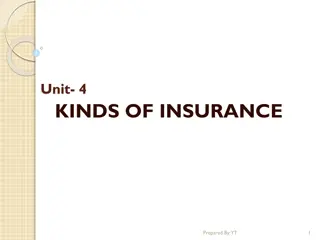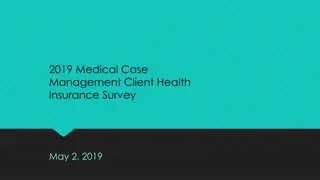Understanding Health Insurance in Challenging Times
Learn about different types of health insurance products such as hospitalization plans, individual and floater health insurance, senior citizen health insurance, and more. Discover tips for choosing the right coverage, whether to opt for individual or floater policy, and key factors to consider while buying health insurance plans. Ensure you have a sufficient sum insured, declare your health status, and check for network hospitals and exclusions. Make informed decisions to safeguard your health and finances.
Download Presentation

Please find below an Image/Link to download the presentation.
The content on the website is provided AS IS for your information and personal use only. It may not be sold, licensed, or shared on other websites without obtaining consent from the author. Download presentation by click this link. If you encounter any issues during the download, it is possible that the publisher has removed the file from their server.
E N D
Presentation Transcript
Health Insurance in Challenging Times By CVO Chartered & By CVO Chartered & Cost Accountants Cost Accountants association association Speaker: Mehul Pujara Speaker: Mehul Pujara Date: 29/05/2021
Type of Health Insurance Products Hospitalisation Plans (Mediclaim Insurance) Individual & Floater Health Insurance Plan Senior Citizen Health Insurance Plan Top Up Plan (Super Top up & Top Up) Disease Specific Plans (Diabetic, Cancer, Dengue etc) Group Health Insurance (Employer/Banks etc) Benefit Plans Critical Illness Plans Hospital Daily Cash Personal Accident Insurance Travel Insurance Domestic Travel International Travel Insurance
Opt for Sufficient sum insured: (minimum 10 times of monthly income) Declare your current health status Buy Early Increase your sum insured with Top up Coverage. Opt for Higher or No room rent limits Cover entire family Look for Co- payment / Sub limit clause Avoid buying to many coverages. Check for claims settlement ratio What to keep in mind while buying Health Insurance Plans Check Network hospital list in your city, District Check exclusions
Should I buy Individual or Floater policy ? Point of Comparison Individual Health Insurance Floater Health Insurance Definition Only one person can be covered in each plan. This means, both the health insurance premium and sum insured is dedicated for one person only and cannot be shared. You and your family members share one plan. This means both your health insurance premium and sum insured would be shared amongst all members in the plan. Advantage The biggest benefit of an individual health insurance plan is that the coverage is a lot more extensive since every individual has their own sum insured, unlike a family floater where the sum insured is shared amongst all insured in the plan. This especially works out well for senior parents. The biggest benefit of a family floater plan is that the health insurance premium is cost effective, as the premium is a one-time premium for all family members. Disadvantage The single disadvantage of an Individual Health Insurance is that one will have enough to cover for them in one policy year. Additionally, even if they haven t claimed during the year, they can benefit from a No Claim Bonus. One of the main disadvantages of a family floater plan is that the sum insured may not be enough for all family members. Preferred Choice An individual health insurance is highly recommended for bigger families, or those with senior parents as a family floater may not be sufficient. A family floater health insurance would work well for a young couple or a small and nuclear families.
Entry Age Limit: Adult: 18 Years to 65 Years Coverages / Benefits Coverages / Benefits Health Insurance (Mediclaim) (Mediclaim) Health Insurance Child: 3 Months to 25 Years Exit Age: No Limit Standard Coverages Advance Coverages In Patient Hospitalisation (24 Hrs Hosp) Day Care Treatment Pre & Post Hospitalisation Domiciliary Hospitalisation No Claim Bonus Room Rent Limit AYUSH Coverage PED after 48 months waiting period 30 Days initial waiting period for all claims other than accident Two years disease specific waiting period Organ Donor Expenses Home Health Care OPD Coverage Maternity Coverage convalescence benefit Reduce PED from 48 months to 36/24 Months Restoration of sum insured Wellness Benefits Critical illness coverage
Entry Age Limit: From 60 Years to 75 Years, Exit Age: No Limit Pre-Medical Check-up (Varies company to Company) PED Waiting period: 1 Year to 4 Year Co-payment 20% to 30% on each claim Disease sub limits: Applicable Coverage: Inpatient Hospitalization, Day care treatment, Pre and Post Hospitalization, Home Health Care, AYUSH Coverage etc. (Coverage very company to company) Senior Citizen Senior Citizen Health Health Insurance Insurance
How the room rent limit impact your claim If the Insured Person is admitted in a room category/limit that is higher than the one that is specified in the Policy Schedule, then the Insured Person shall bear a ratable proportion of the total Associated Medical Expenses in the proportion of the difference between the Room Rent of the entitled room category to the Room Rent actually incurred. Associated Medical Expenses shall include - Room Rent, nursing charges, operation theatre charges, Practitioner including surgeon/ anesthetist/ specialist within the same Hospital where the Insured Person has been admitted. Associated Medical Expenses does not include cost of pharmacy and consumables, cost of implants and medical devices and cost of diagnostics. Proportionate deductions are not applicable for ICU charges
Room Rent Proportionate calculation Room Rent Proportionate calculation Mr. A is admitted in a hospital for Hip Replacement surgery. His sum insured is 300,000 and room rent eligibility is 1% if Sum Insured i.e. Rs. 3,000/- per day He opted higher room rent category of Rs. 4,000 per day. Proportionate deduction = Room Rent Allowed / Actual Room Rent * 100 Example A: 3,000/4,000*100 = 75% B Example B: 3,000/10,000*100 = 30% A Insured Hospital Bill Insured Hospital Bill Propotion Rate Settled Amount Propotion Rate Settled Amount Room Rent for 10 days Room Rent for 10 days 40,000 30% 12,000 40,000 75% 30000 Cost of Hip Replacement Surgery Cost of Hip Replacement Surgery 1,75,000 30% 52,500 1,75,000 75% 131250 Doctor Visits Doctor Visits 50,000 30% 15,000 50,000 75% 37500 Tests Tests 10,000 30% 3,000 10,000 75% 7500 Pharmacy & Consumables Pharmacy & Consumables 25,000 100% 25000 25,000 100% 25,000 Total Total 3,00,000 2,31,250 3,00,000 1,07,500
Sub Limit / Co- payment Non Payable Items Standard Exclusions Waiting Period Initial Waiting Period 30 Days First Two Year Waiting Period 48 Months Waiting Period Pre Existing Disease waiting period Room Rent Sub Limits Disease wise Sub Limits Co-payment Excess Cosmetic, Personal Comfort items, Surcharge Attendance Charges Email/Telephone Charges Laundry Charges Buds Investigation & Evaluation Charges Rest Cure, Rehabilitation Obesity/Weight Control Cosmetic, Plastic Surgery Breach of law Treatment taken outside India OPD expense Let s Let s understand understand
Pre-existing Disease - means any condition, ailment, injury or disease: a)That is/are diagnosed by a physician within 48 months prior to the effective date of the Policy issued by the insurer or its reinstatement or b) For which medical advice or treatment was recommended by or received from, a physician within 48 months prior to the effective date of the Policy issued by the insurer or its reinstatement. What is included and excluded from the criteria of pre-existing diseases in health insurance? Pre-existing diseases in health insurance generally include now common diseases like blood pressure, diabetes, thyroid, and cholesterol. It is important to understand that common diseases like fever, viral flu, cough and cold, etc., which don t have any potential to get severe in the long run, are not included in pre-existing diseases. Let s What happens if I don t disclose pre-existing diseases? understand PED Non-disclosure of the pre-existing disease can result in denial at the time of renewal of the policy or dishonoring of claims if made for such diseases. Is there any effect of pre-existing diseases on the amount of premium? Yes, generally, the amount of insurance premium is higher in case of pre-existing illnesses as the chances of making a claim is higher in such cases.
Sl 1 2 3 4 5 6 7 8 Item BABY FOOD BABY UTILITIES CHARGES BEAUTY SERVICES BELTS/ BRACES BUDS COLD PACK/HOT PACK CARRY BAGS EMAIL / INTERNET CHARGES Sl 35 36 37 38 39 40 41 42 Item OXYGEN CYLINDER (FOR USAGE OUTSIDE THE HOSPITAL) SPACER SPIROMETRE NEBULIZER KIT STEAM INHALER ARMSLING THERMOMETER CERVICAL COLLAR List of Non- Payable Items 9 FOOD CHARGES (OTHER THAN PATIENT's DIET PROVIDED BY HOSPITAL) 43 SPLINT 10 11 12 13 14 15 16 17 18 19 LEGGINGS LAUNDRY CHARGES MINERAL WATER SANITARY PAD TELEPHONE CHARGES GUEST SERVICES CREPE BANDAGE DIAPER OF ANY TYPE EYELET COLLAR SLINGS 44 45 46 47 48 49 50 51 52 53 DIABETIC FOOT WEAR KNEE BRACES (LONG/ SHORT/ HINGED) KNEE IMMOBILIZER/SHOULDER IMMOBILIZER LUMBO SACRAL BELT NIMBUS BED OR WATER OR AIR BED CHARGES AMBULANCE COLLAR AMBULANCE EQUIPMENT ABDOMINAL BINDER PRIVATE NURSES CHARGES- SPECIAL NURSING CHARGES SUGAR FREE Tablets CREAMS POWDERS LOTIONS (Toiletries are not payable, only prescribed medical pharmaceuticals payable) ECG ELECTRODES GLOVES NEBULISATION KIT ANY KIT WITH NO DETAILS MENTIONED [DELIVERY KIT, ORTHOKIT, RECOVERY KIT, ETC] 20 BLOOD GROUPING AND CROSS MATCHING OF DONORS SAMPLES 54 21 22 23 SERVICE CHARGES WHERE NURSING CHARGE ALSO CHARGED Television Charges SURCHARGES 55 56 57 24 ATTENDANT CHARGES 58 EXTRA DIET OF PATIENT (OTHER THAN THAT WHICH FORMS PART OF BED CHARGE) BIRTH CERTIFICATE CERTIFICATE CHARGES COURIER CHARGES CONVEYANCE CHARGES MEDICAL CERTIFICATE MEDICAL RECORDS PHOTOCOPIES CHARGES MORTUARY CHARGES WALKING AIDS CHARGES 25 59 KIDNEY TRAY 26 27 28 29 30 31 32 33 34 60 61 62 63 64 65 66 67 68 MASK OUNCE GLASS OXYGEN MASK PELVIC TRACTION BELT PAN CAN TROLLY COVER UROMETER, URINE JUG AMBULANCE VASOFIX SAFETY
How Top Up & Super Top plan works Super top-up plans are similar to top-up plans, except that top-up plan covers a single claim above the threshold limit, while the super top-up plan covers the total of all hospitalization bills above the threshold limit Top Up Example Super Top Up Example Particular A B C No of claims in a Year Claim 1 Claim 2 Claim 3 Claims 1 < 5 Lakh Claim 2 < 5 Lakh Claim 3 < 5 Lakh Aggregate Deductible as per policy (Threshold Limit) Sum Insured Coverage as per policy Claim Payable Amount Particular A B C No of claims in a Year Claim 1 Claim 2 Claim 3 Total Claims in a Year (A+B+C) Deductible as per policy (Threshold Limit) Sum Insured Coverage as per policy Claim Payable (D-E) Amount 3,00,000 2,00,000 2,00,000 3,00,000 2,00,000 2,00,000 No claims > 5 Lakh D 7,00,000 D E 5,00,000 E 5,00,000 F G 10,00,000 2,00,000 F G 10,00,000 Not Payable F Balance Sum Insured (F-G) 8,00,000 F Balance Sum Insured (F-G) 10,00,000
Claim Process Cashless Member approaches with Network Hospitals with ID Hospital sends Intimation to TPA Reimbursement Member approaches Any other Hospital Out of Pocket payment Eligibility Not Avails treatment, makes upfront payment Submits bills to TPA for reimbursement Covered Covered Authorization as per eligibility Cashless treatment at NWH
Recent Regulatory Changes by IRDAI 1. Certain exclusion not allowed in Health Insurance Policy: Internal Congenital, Genetic Disease, Disease after buying health insurance policy, Injury or illness due to hazardous activities, Treatment for metal illnesses, psychological disorder, Age related macular degeneration 2. Standardization of Exclusion wordings 3. Only 16 disease are allowed to be permanently exclusion in case of PED 4. Coverage for Morden and advance treatment 5. Moratorium of 8 Years. Means no claim can be rejected after completion of 8 years in a policy. 6. Waiting period for lifestyle disease not allowed for more than 90 days 7. Delay in a claim settlement beyond 30 days after receiving all the documents insurer need to pay 2% interest above the applicable bank rate.
The reimbursement claim is to be supported with the following documents and submitted within the prescribed time limit. Duly Completed claim form Photo Identity proof of the patient Medical practitioner s prescription advising admission Original bills with itemized break-up Payment receipts Discharge summary including complete medical history of the patient along with other details. Investigation/ Diagnostic test reports etc. supported by the prescription from attending medical practitioner Claim Documents OT notes or Surgeon s certificate giving details of the operation performed (for surgical cases). Sticker/Invoice of the Implants, wherever applicable. MLR(Medico Legal Report copy if carried out and FIR (First information report) if registered, where ever applicable. NEFT Details (to enable direct credit of claim amount in bank account) and cancelled cheque KYC (Identity proof with Address) of the proposer, where claim liability is above Rs 1 Lakh as per AML Guidelines Legal heir/succession certificate , wherever applicable Any other relevant document required by Company/TPA for assessment of the claim.
Incorrect information in proposal form Waiting Period clause Pre-existing disease Not knowing the exclusions Lapse of Policy Late intimation to insurer Common reasons behind health insurance claims rejection
How to prevent claim rejection First and foremost, keep in mind to go through all the policy wordings in addition to terms and conditions in a detailed manner. Being unaware of exclusions, deductibles, and claim processes and other critical details will end up getting you confused or regretting the decision of investing in the wrong policy. The best thing you can do to avoid the insurance claim rejected status is to fill up the form yourself and in case of any doubts, take the help of the insurer or agent. Don t get the form filled by anyone else, other than yourself. Double-checking the insurance claim for accuracy is what you should also practice. Giving correct information regarding medical condition is something that you should do without giving a second thought, if you want to prevent claim rejection at a point when you need the medical help the most. One must not forget to make copies of all the documents they provide with the claim form for the health insurance policy. By doing so, it will be easy for the policyholder to provide TPA with the reference, in case the need arises in the future. Providing all medical records to the TPA or Third Party Administrator is an essential element to keep in mind. If it is the case of post-hospitalisation costs incurred, providing the details and submission must be carried out within a span of 90 days from the hospitalisation date. Renewing the health insurance policy within the time frame will help you avoid any inconvenience at the time of claiming. Though a 30-day grace period is provided by the insurer, it is important for one to renew their policy beforehand. For planned hospitalisation, it s better to look for the insurer s approval in advance. However, in case of a medical emergency, one can proceed with the treatment and inform the insurer within 2 or 3 days of hospitalisation.
ADVANTAGES OF CORONA KAVACH POLICY No Room Rent Limit: The policy doesn t have a room rent limit. So, policyholders don t have to shell out money from their own pockets. Shorter waiting period: Corona Kavach Policy has a short waiting period of 15 days. This means Covid-19 will be covered after 15 days from the issuance of your policy. Should I buy Corona specific policy or comprehensive health insurance policy Covid-19 coverage: All Covid-19 related hospitalization expenses are covered under the policy including PPE kit, gloves, mask, ICU expenses, ventilator charges, specialist fees. Treatment at home covered: Insurer will cover the costs of treatment at home on a positive diagnosis of Covid-19 from a government authorized diagnostic Centre; maximum up to 14 days per incident. Affordable premium: Since this policy is valid till March 31, 2021 / 30th September 2021, the premiums are very cheap as compared to comprehensive health insurance policies which are lifelong renewable. LIMITATIONS OF CORONA KAVACH POLICY Short term policy (Temporary product): The policy is valid only up to March 31, 2021 / 30th September 2021, and can not be renewed once product is withdrawn , unlike a comprehensive health insurance cover which is lifelong renewable. The policy tenure is three and a half months, six and half months, and nine and half months including the waiting period. No coverage for other illnesses except Covid-19: Unlike a comprehensive health insurance plan, which provides coverage for all illnesses, Corona Kavach provides coverage for Covid-19 only. Low sum insured: Corona Kavach is available at the low sum insured options from Rs 50,000- Rs 5 lacs which isn t enough keeping in mind the rise in medical inflation and expensive treatment of Covid-19.
Not Satisfied or claims denied File a complaint COMPLAINT TO GRO OF INSURANCE COMPANY FILE COMPLAINT WITH IRDAI APPROACH CONSUMER COURT























